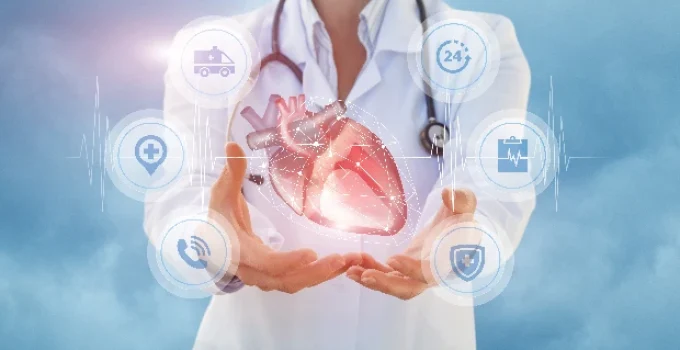What Are the Parts of the Cardiovascular System?
The cardiovascular system is one of the most important systems in your body. It’s in charge of transporting blood, oxygen, and nutrients to every cell. But how does it work? It all comes down to the parts that make up the system—each with a specific job to do.
In this article, we’ll explore the different parts of the cardiovascular system and learn how they work together to keep you alive and healthy.
Dive Deeper
- What Is the Cardiovascular System?
- The Heart: Your Body’s Powerful Pump
- The Blood Vessels: Your Internal Roadways
- The Blood: Your Body’s Delivery System
- How the Parts of the Cardiovascular System Work Together
- Table: Main Parts and Their Roles
- 🎯 Final Thoughts
- 📚 References
What Is the Cardiovascular System?
The cardiovascular system (also called the circulatory system) is made up of the heart, blood vessels, and blood. Together, these three parts work like a high-speed delivery service. They make sure oxygen and nutrients go where they’re needed—and carry away waste products to keep your body clean and healthy.
Let’s take a closer look at the system, part by part.
The Heart: Your Body’s Powerful Pump
Your heart is the most important part of the cardiovascular system. It’s a strong, muscular organ that pumps blood around your body day and night.
Quick facts about the heart:
- It’s about the size of your fist.
- It has four chambers: two atria (top) and two ventricles (bottom).
- It beats around 100,000 times a day.
- It sends blood to the lungs and then to the rest of the body.
The heart works like a pump with two sides:
- The right side sends blood to the lungs to get oxygen.
- The left side sends oxygen-rich blood to the rest of the body.
Without the heart, your body wouldn’t get the fuel it needs to survive.
The Blood Vessels: Your Internal Roadways
Blood vessels are the “roads” your blood travels on. There are three major types:
- Arteries – These carry oxygen-rich blood away from the heart to the body. They are thick and strong.
- Veins – These bring oxygen-poor blood back to the heart. They have valves to keep blood moving in the right direction.
- Capillaries – These are the tiniest blood vessels. They connect arteries and veins and allow oxygen and nutrients to move into cells.
🚨 Did you know? If you stretched out all your blood vessels, they would be about 60,000 miles long—long enough to circle the Earth two and a half times!
The Blood: Your Body’s Delivery System
Blood is the fluid that travels through the vessels and carries everything your body needs.
What’s in blood?
- Red blood cells – Carry oxygen to your cells.
- White blood cells – Fight germs and infections.
- Platelets – Help your blood clot when you get a cut.
- Plasma – The liquid part that carries nutrients, hormones, and waste.
🩸 The average human has about 1.2 to 1.5 gallons of blood in their body. That’s about the size of a large milk jug!
How the Parts of the Cardiovascular System Work Together
Here’s how the system flows:
- Blood enters the heart from the veins (low in oxygen).
- The heart sends it to the lungs to pick up fresh oxygen.
- The oxygen-rich blood comes back to the heart.
- The heart pumps it through the arteries to the rest of the body.
- Capillaries drop off oxygen and nutrients to cells and pick up waste.
- Blood returns to the heart through the veins, and the cycle starts again.
🔁 This loop continues nonstop, delivering everything your body needs to survive.
Table: Main Parts and Their Roles
| Part | Function |
|---|---|
| Heart | Pumps blood to lungs and body |
| Arteries | Carry oxygen-rich blood away from heart |
| Veins | Bring oxygen-poor blood back to the heart |
| Capillaries | Exchange oxygen, nutrients, and waste with cells |
| Red Blood Cells | Transport oxygen |
| White Blood Cells | Fight infections |
| Platelets | Help blood clot |
| Plasma | Carries nutrients, waste, and hormones |
🎯 Final Thoughts
The cardiovascular system is like a team of super workers that never rest. The heart pumps, the vessels carry, and the blood delivers. Without any of these parts, your body wouldn’t be able to function properly.
So the next time you feel your pulse or hear your heart beating, remember—it’s all part of a powerful system working to keep you alive, healthy, and strong.
📚 References
- KidsHealth. “Heart and Circulatory System.”
- American Heart Association. “How the Heart Works.”
- National Institutes of Health. “Your Guide to the Circulatory System.”
- InnerBody. “Cardiovascular System.”
- CDC. “Heart Disease Facts.”
📌Learn More About the Cardiovascular System
- What Is the Cardiovascular System and Why Do We Need It?
- What Are the Parts of the Cardiovascular System?
- How Does the Heart Pump Blood?
- What Are Arteries and Veins, and How Are They Different?
- Why Is Blood Red?
